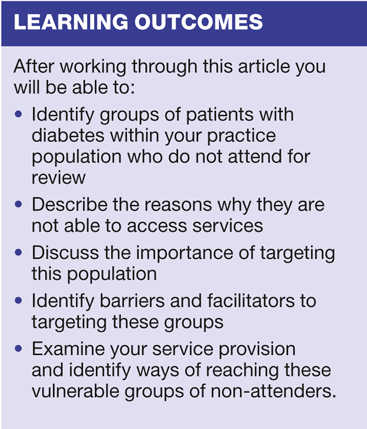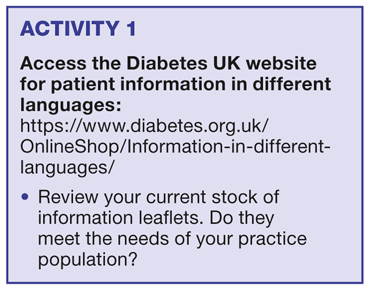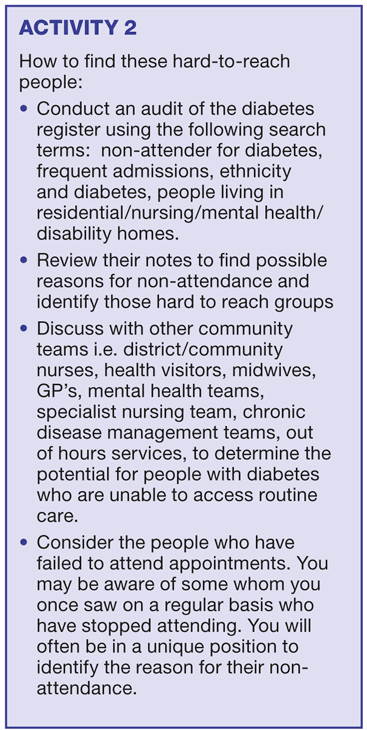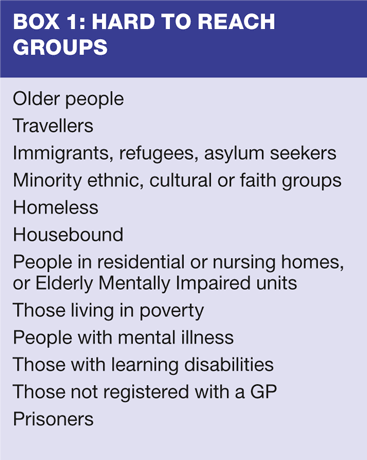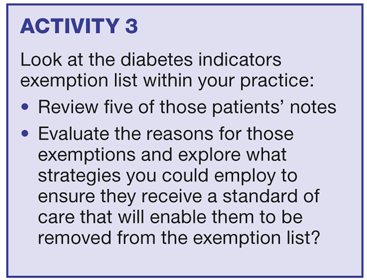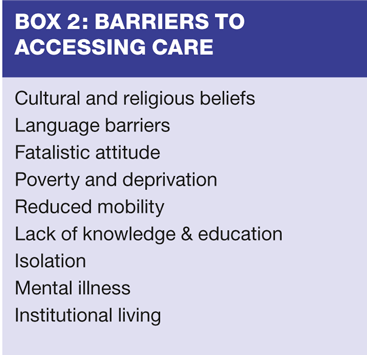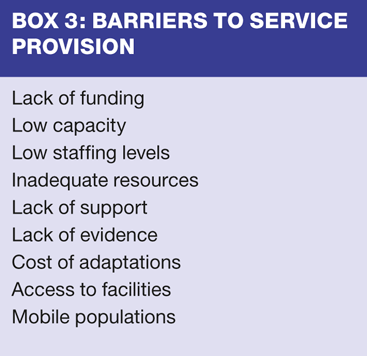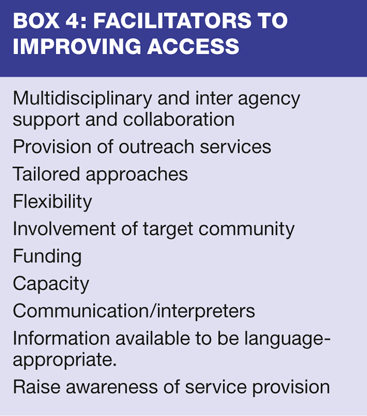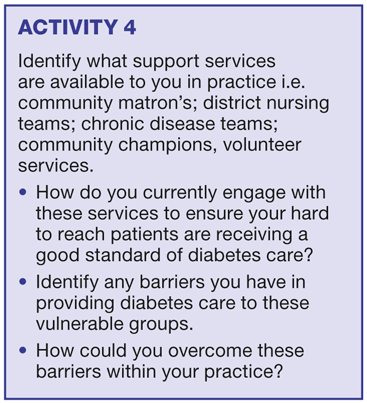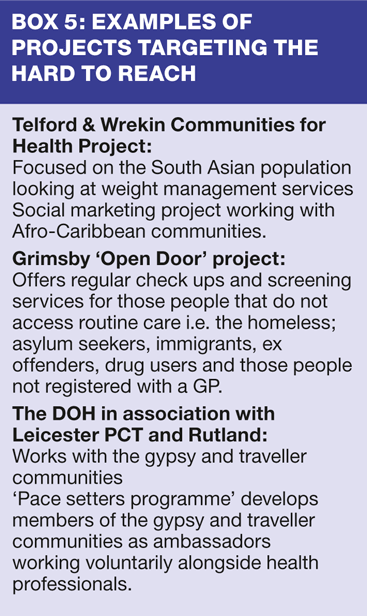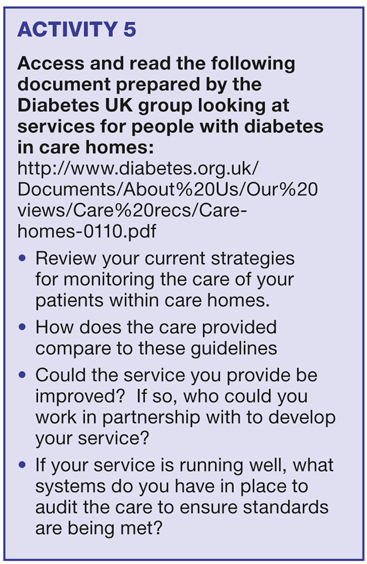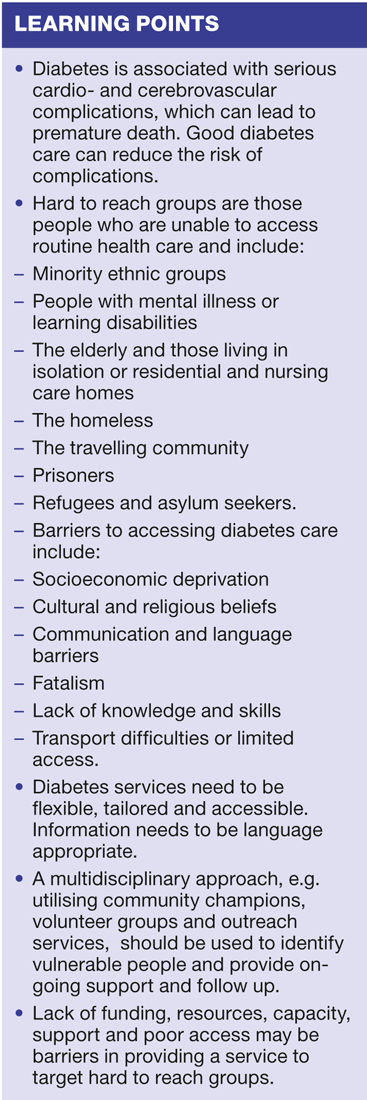Diabetes - targeting the non-attenders
Chris Cottrell
Chris Cottrell
BSc, RGN, EN, Dip Nursing
Clinical lead for Diabetes/AF & Hypertension, Education for Health.
The Quality and Outcomes Framework rewards practices for achieving quality indicators for diabetes. This is good for those able to access services, but what happens to those unable or unwilling to access care?
There are approximately 2.8million people in the UK with a diagnosis of diabetes,1 and a further estimated 850,000 who remain undiagnosed.2 Approximately 90% of these individuals have type 2 diabetes,3 the majority of whom are managed in primary care. The Quality and Outcomes Framework (QOF)4 rewards practices for achieving set outcomes for diabetes. This is ideal for those able to access care, either in general practice or via secondary care, but what happens to those who are unable to or unwilling to take advantage of the services offered?
WHO ARE THE 'HARD TO REACH'?
A variety of terms are used to describe these groups of individuals:
- Hard to reach
- Vulnerable
- Disadvantaged
- Minority.
The various groups to which these terms can be applied are summarised in Box 1, and some individuals will be members of more than one group. They are often deemed to be difficult to manage and can be challenging for both primary and secondary care, and for social care services. How do the members of such groups access diabetes reviews? How can we ensure an adequate level of care for these individuals to avoid complications or prevent the risk of further deterioration?
Minority ethnic populations have a higher incidence of diabetes and approximately 10% of prisoners are from minority ethnic populations.5,6 The prevalence of diabetes within the prison population is therefore high. Ignorance of prison officers and a lack of education amongst staff and prisoners can lead to misunderstandings about monitoring, diet and medications. The symptoms of hypoglycaemia also often go unrecognised in these people.7
The homeless and those not registered with a GP remain difficult to target. To date there is little evidence of projects successful in reaching these groups. More encouraging are the projects with the travelling community and prisoners. This article will focus on ways of targeting non-attenders in primary care, such as the elderly and ethnic populations and those with mental health problems and/or learning disabilities.
IMPORTANCE OF TARGETING NON-ATTENDERS
Diabetes is associated with serious cardiac and cerebrovascular disease, as well as small vessel disease that can result in blindness and renal failure.8 It reduces life expectancy by approximately 20 years in type 1 diabetes and 10 years in type 2 diabetes.9 At the time of diagnosis half of those with type 2 diabetes will already have complications.10 Good diabetes management reduces the risk of complications, which is why it is important to make every effort to reach the non-attenders.11,12
REASONS WHY PEOPLE DO NOT ATTEND
Socio-economic deprivation
Socio-economic deprivation is one of the main reasons people are unable to access health care. Deprivation is strongly associated both with risk factors for developing diabetes and with the risk of serious complications from it.13,14 The most deprived people in the UK are two-and-a-half times more likely to have diabetes at any given age.15
Those on low incomes may have difficulty accessing public transport, they may view health care as a low priority and may have low expectations of their health, often assuming that this is 'their lot'. They may lack the knowledge, skills and support to manage their condition. It is an unfortunate fact that the 'inverse care law' first described 40 years ago (those most likely to need medical care and support are those most likely to experience difficulty accessing it) still applies to diabetes, as it does to other health problems.16
Ethnicity, cultural beliefs and language
Some minority ethnic groups, particularly South Asian, African and Afro-Caribbean, are at particularly high risk of developing type 2 diabetes.15,5 They also experience increased levels of morbidity from complications of the disease. This increased risk and morbidity has been attributed to a variety of causes:
- socio economic deprivation
- population mobility
- language and communication difficulties
- cultural and religious differences
- limited access to services.5
For minority ethnic groups, refugees and asylum seekers, cultural beliefs as well as language barriers may prevent them accessing health care. People with diabetes in minority ethnic groups are less likely to have an annual diabetes check17 and in 2004-2005 approximately 40% of Primary Care Trusts had no strategy to address the problem in these communities.1
Even when individuals from minority groups access care we may not be meeting their needs. A survey of people from South Asian communities found that advice was not always specifically tailored to their needs and a lack of follow-up services meant that they had no on-going support.6
Ageing Society
People are living longer. By 2050 there will be approximately two billion people over the age of sixty; 1 in 5 people globally.18 The number of people with diabetes in the 20-79 year age group is set to increase to 439 million by 2030.19
More people will be living in isolation or in residential and nursing home care.1 Diabetes is thought to affect 10-25% of this population20 and diabetes care within these areas is often substandard. A large retrospective study, involving over 10,000 care home residents and over 400,000 residents in the community over the age of 65 years, compared quality of care for chronic disease among older people in residential/nursing homes with standard community care in relation to the QOF.21 Achievement of quality indicators was significantly lower for those residing in care establishments compared to the general community, with the largest differences being seen in prescribing for heart disease and monitoring of diabetes. There was also a 34.5% rate for exemption from QOF indicators for these people.1 Evidence also suggests that, in many cases, people in long-term care homes are being over treated for diabetes.22
Residential Care Home Communities
Diabetes UK identified that there may be as many as 13,500 older people living in care homes whose diabetes has not been identified.23
Six out of ten private sector and local authority homes do not provide training in diabetes for their staff. Staff turn over is often rapid, making provision and maintenance of training difficult and costly. However, the implementation of care standards, requiring that each individual is assessed for diabetes and that each person identified has a personalised plan of care, may ensure that training and education takes place and a standardised level of care is achieved.
Mental Health and Learning Disability
Severe mental illness is associated with type 2 diabetes.24 People with learning disabilities and those with mental health problems may have impaired cognitive and reasoning abilities, and/or co-morbidities and physical disability, making access to routine health care services more difficult.25 Access may be dependent on their carers and they may also have difficulties communicating symptoms etc. effectively.6
Approximately 30-50% of homeless people have severe mental illness and may have diabetes and other chronic disease.
Other barriers
Language barriers create communication problems between clinician and patient. There are organisations that produce leaflets and booklets in numerous languages. There are also interpreters and helplines to assist where language barriers are an issue. We should, however, also consider communication in terms of written information. More than 5 million people in the UK have impaired literacy and/or numeracy skills.26 This can impede communication and be a significant barrier to the fostering of self management skills.
Primary care practitioners, particularly commissioners of services, may identify other barriers, e.g. lack of funding and resources, not enough staff to conduct reviews. Many chronic disease management clinics within general practices have become so 'stretched' it is difficult to focus on people that cannot access routine care. District nursing teams do not always have the capacity to conduct routine diabetes reviews. Unless service provision is funded and resourced specifically with the aim of addressing these issues then difficulties will continue.
Services within the community, linked to general practice, may be in place, but poor inter-agency working may offer little or no opportunity to recognise where collaborative working might address some of the gaps in health care (Box 3).
WHERE DO YOU START?
Think about your practice population. Who are the hard to reach groups within your area? (Box 1) This could be a starting point for identifying groups of people who are unable or choose not to access routine services.
Approximately, one in ten people admitted to hospital have diabetes, of which 60% are emergency admissions.13 Those who are admitted frequently may have been 'missed' from routine care or have difficulty accessing it. An audit of your 'frequent flyers' may highlight those that do not attend the practice and may also be the evidence needed to facilitate new services, or improve existing ones in order to prevent future ill health and avoid further admissions.
Examination of your QOF data is another means of identifying those who do not access routine care, and the reasons for it.
A multidisciplinary approach needs to be taken in diabetes care. It is important to engage with the health visitors, district nursing teams (including your community matron), the diabetes specialist and any other community services e.g. pharmacists, community champions and agencies including mental health, social services and outreach services. This may give an insight to the number of people in your area that require service provision who are potentially being missed. Working together may help generate ways of ensuring these people are able to access a standard level of diabetes care provision. This may include screening for those with risk factors for developing diabetes and not just targeting those with established disease. A questionnaire to service providers within your area, including general practice, nursing, residential and learning disabled homes and day centres, may serve to identify the education and training needs of staff and to recruit support from those who may be interested in improving services.
MAKING SERVICES ACCESSIBLE
There are a number of facilitators for improving services. (Box 4) Services need to be tailored to the needs of disadvantaged groups and should be flexible, e.g. use of appropriate facilitators in faith centres, community centres and other community-based locations. Support from other professionals, such as community pharmacists, specialist nurses in diabetes, community matrons, expert patient groups, etc. can help drive change.
Outreach clinics, working in partnership with other health care professionals are another way forward. A systematic review of specialist outreach clinics, looking at 73 outreach interventions from differing specialities and countries, has been conducted. Most of the studies came from non-disadvantaged populations but the results indicate that these clinics can improve access to care, service use and outcomes.27
Effective inter-agency working, with support from appropriately trained people, skilled in communication and cultural awareness and able to access disadvantaged communities, can also provide a way forward. They can help provide the care, support and follow-up needed to ensure continuity of care and successful intervention. Community champions enable access to Black and Asian minority groups. They are a source of knowledge and life experience and are able to target information with sensitivity and respect. They may also be able to deliver risk assessments and reviews within these communities.1 The development of a template or care plan for use by those willing to deliver such services will help to ensure that care meets National Framework standards, the needs of the patient and QOF.
Diabetes UK appointed a group to look at services for people with diabetes in care homes and develop good clinical practice guidelines. These provide a framework of evidence-based, practical and implementable diabetes care recommendations within this setting. It includes diabetes education as part of care home staff training.28
There is some evidence supporting tele-homecare (tele-health) in diabetes for 'hard to reach' patients. However, the cost of the technology and time for training and education may be problematic. In addition, the views of patients are variable. Some perceive the equipment as inconvenient, or did not use it. Others found it useful and user friendly. It is hoped that in the future this may be a way of reaching people whilst reducing the number of potential home visits.29-32
GOOD PRACTICE
Whilst there are good examples of chronic disease management in some areas, this is variable. Lord Darzi's report33 suggests that services should ensure that people, including those traditionally unlikely to seek help or who find themselves discriminated against, should receive an equitable, personalised service that is fit for their needs, when they need it.
The Diabetes UK website contains examples of good practice, with contact details for projects targeting specific 'hard to reach' vulnerable and/or disadvantaged communities. Table 5 describes just some examples that could be replicated to other areas.
NICE will be publishing a report this year reviewing methods of monitoring adults at high risk of developing type 2 diabetes, and interventions to prevent progression to type 2 diabetes in disadvantaged and vulnerable groups.
This should provide examples of work, undertaken or on-going, within the UK and should provide useful data to inform potential service improvements.
CONCLUSION
In order to prevent complications and further deterioration of existing disease, vulnerable people with diabetes need to be identified and offered a flexible, culturally sensitive and integrated care service that will address their health care needs. Identifying barriers and facilitators will help the planning and commissioning of new services or identify ways to improve existing services. Clinical commissioning has the potential to allow GP practices, working with other primary and community clinicians, to develop new services for their patients, or improve existing ones to better meet their needs.
REFERENCES
1. Carruthers I, Philip P Safety First - A report for patients, 1. Diabetes UK. Let's beat diabetes. Diabetes Impact Report. 2010 http://www.diabetes.org.uk/Documents/About%20Us/Our%20impact/Impact_Report2010-28.9.11.pdf
2. Holt TA, Stables D, Hippisley-Cox, J, et al. Identifying undiagnosed diabetes: cross-sectional survey of 3.6 million patients' electronic records. BJGP 2008;58:192-196.
3. Khardori R, Griffing GT. Type 2 diabetes mellitus. 2011 http://emedicine.medscape.com/article/117853-overview#showall
4. Quality and Outcomes Framework Guidance for GMS Contract (2011/2012) Delivering investment in general practice. BMA. 2011 http://www.nhsemployers.org/Aboutus/Publications/Documents/QOF_guidance_GMS_contract_2011_12.pdf
5. Diabetes UK. Diabetes and the disadvantaged: reducing health inequalities in the UK. A report by the All Parliamentary Group for Diabetes and Diabetes UK. 2006 http://www.diabetes.org.uk/Documents/Reports/Diabetes_disadvantaged_Nov2006.pdf
6. DUK Scotland (2006) Better diabetes Care Survey Report. 1-24 http://www.diabetes.org.uk/Documents/Reports/Better%20Diabetes%20Care%20Scotland%202009.pdf
7. Gill GV, MacFarlane IA, Tucker N. Diabetes care in British prisons: existing problems and potential solutions. Diabetic Med 1992:9;109-113.
8. Fowler MJ. Microvascular and macrovascular complications of diabetes. Clin Diabetes 2008:26(2);77-82.
9. White C, Edgar G. Inequalities in healthy life expectancy by social class and area type: England, Health Statistics Quarterly 2010: 45 (Spring);28-56.
10. Department of Health. National Service Framework for Diabetes. 2007 http://www.dh.gov.uk/en/Publicationsandstatistics/Publications/PublicationsPolicyAndGuidance/Browsable/DH_4096591
11. Stratton IM, Adler AI, Neil HAW et al. Association of glycaemia with macrovascular and microvascular complications of Type 2 diabetes (UKPDS 35): prospective observational study. BMJ 2000:321;405-412.
12. UK Prospective Diabetes Study Group (UKPDS) (1998) Tight blood pressure control and risk of macrovascular and microvascular complications in Type 2 diabetes: UKPDS 38. BMJ 1998: 317(7160);703-713.
13. The NHS Information Centre. Health Survey for England 2006. Cardiovascular disease and risk factors in adults. The Information Centre. 2008 www.ic.nhs.uk/webfiles/publications/HSE06/HSE%2006%20report%20VOL%201%20v2.pdf
14. NHS Evidence. Making every young person matter. DOH. 2007 www.diabetes.org.uk/Documents/Reports/MakingEveryYoungPersonMatter.pdf.
15. The Information Centre. Health Survey for England 2004. Health of ethnic minorities. The Information Centre. 2008 www.ic.nhs.uk/statistics-and-data-collections/health-and-lifestyles-related-surveys/health-survey-for-england/health-survey-for-england-2004:-health-of-ethnic-minorities-full-report
16. Tudor Hart J. The inverse care law. Lancet 1971:297(7696); 405-12.
17. Diabetes UK. UKDI ABS Annual Report. Diabetes UK. London. 2001
18. Help Aged International (2010) http://www.helpage.org/resources/publications/
19. Shaw JE, Sicree RA, Zimmet PZ. Global estimates of the prevalence of diabetes for 2010 and 2030. Diabetes Res Clin Pract 2010:87; 4-14.
20. Croxson S. Diabetes in the elderly: problems of care and service provision. Diabetic Med 2002: 19(Suppl s4):66-72.
21. Shah SM, Carey IM, Harris T, Dewilde S, Cook DG. Quality of chronic disease care for older people in care homes and the community in a primary care pay for performance system: retrospective study. BMJ 2011:342; d912.
22. Bouillet B, Vaillant G, Petit JM, Ducios M, Poussier A, Brindisi MC, Verges B. Are elderly patients with diabetes being overtreated in French long-term-care homes? Diabetes Metab 2010:36(4); 272-7.
23. Diabetes UK. Diabetes in care homes. Awareness, screening, training survey. 2010: 1-27. http://www.diabetes.org.uk/Documents/Reports/Better%20Diabetes%20Care%20Scotland%202009.pdf
24. Dixon LB, Kreyenbuhl JA, Dickerson FB, Donner TW, Brown CH, Wohlheiter K, Postrado L, Goldberg RW, Fang L, Marano C, Messias E. A comparison of type 2 diabetes outcomes among persons with and without severe mental illnesses. Psychiatr Serv 2004:55(8):892-900.
25. Schizophrenic and Diabetes 2003' Expert Consensus Meeting Consensus summary. BJ Psych 2004: 184(Supplement 47); s112-S114.
26. House of Commons Public Accounts Committee. Skills for Life: Progress in Improving Adult Literacy and Numeracy. The Stationery Office, London. 2009 Available at: www.tinyurl.com/dmcywk
27. Gruen RL, Weeramanthri TS, Knight SE, Bailie RS. Specialist outreach clinics in primary care and rural hospital settings. Cochrane Database Syst Rev 2004:1; CD003798
28. Sinclair AV. Task and Finish Group of Diabetes UK. Good clinical practice guidelines for care home residents with diabetes: an executive summary. Diabetic Med 2011: 28(7); 772-7. http://www.diabetes.org.uk/Documents/Get%20involved/WDD/2010/Care_homes_report2010.pdf
29. Liddy C, Dusseault JJ, Dahrouge S, Hogg W, Lemelin J et al. Telehomecare for patients with multiple chronic illnesses: Pilot study. Can Fam Physician 2008:54(1);351.
30. Starren J, Tsai C, Bakken S, Aidala A, Morin PC et al. The role of nurses in installing telehealth technology in the home. Comput Inform Nurs 2005: 23(4);181-9.
31. Kaufmann DR, Patel VL, Hiliman C, Morin PC, Pevzner J et al. Usability in the real world: assessing medical information technologies in patients' homes. J Biomed Inform 2003:36(1-2);45-60.
32. Currel R, Urquhart C, Wainwright P, Lewis R. Telemedicine versus face to face patient care: effects on professional practice and health care outcomes. Cochrane Database Syst Rev 2000:(2);CD002098.
33. Darzi A. High Quality Care for All: NHS Next Stage Review (Final Report). Department of Health; London. 2008. pp1-54
Related articles
View all Articles

